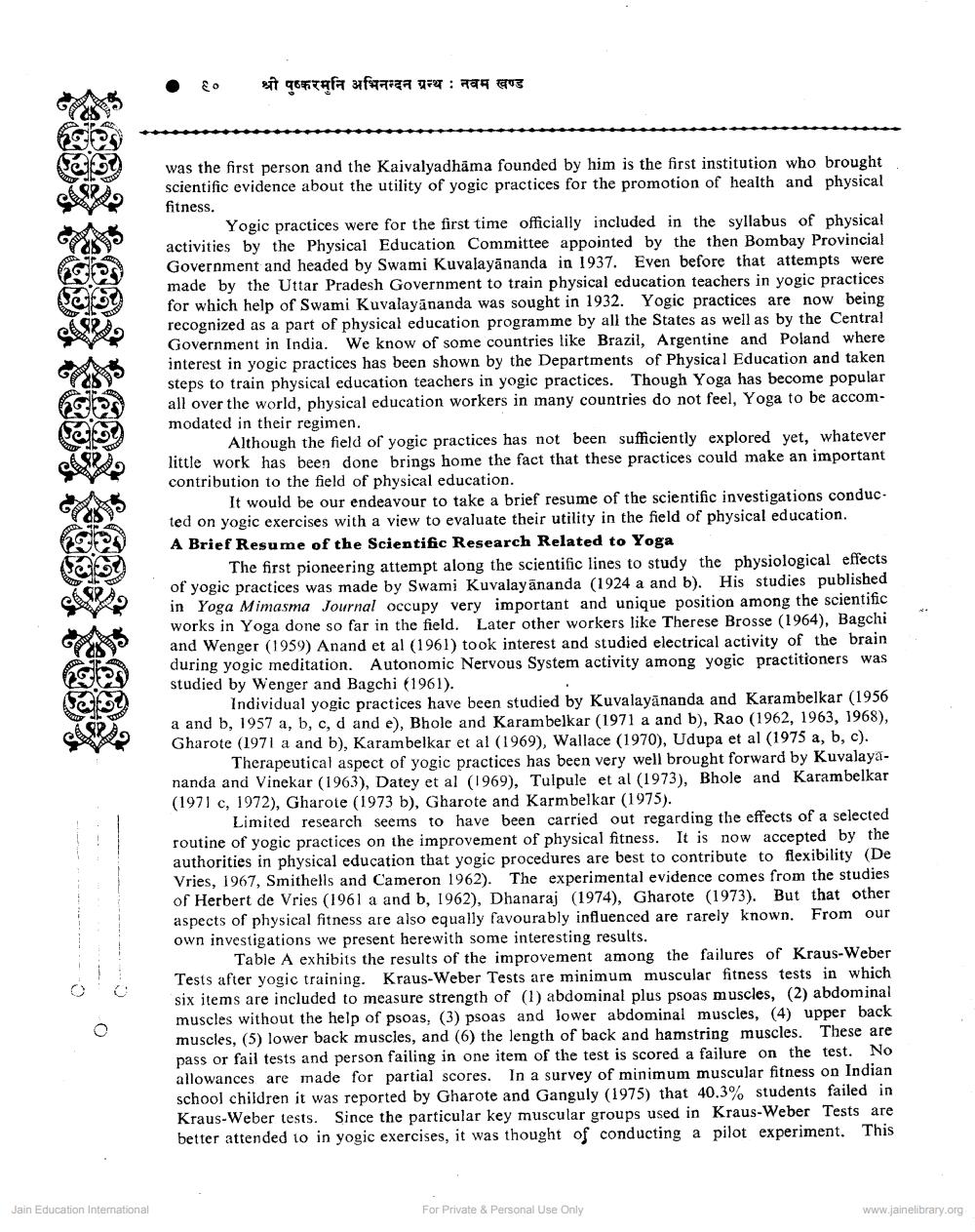Book Title: Yoga in Physical Education Author(s): M L Gharote Publisher: Z_Pushkarmuni_Abhinandan_Granth_012012.pdf View full book textPage 3
________________ ६० श्री पुष्करमुनि अभिनन्दन ग्रन्थ : नवम खण्ड AP no to was the first person and the Kaivalyadhāma founded by him is the first institution who brought scientific evidence about the utility of yogic practices for the promotion of health and physical fitness. Yogic practices were for the first time officially included in the syllabus of physical activities by the Physical Education Committee appointed by the then Bombay Provincial Government and headed by Swami Kuvalayānanda in 1937. Even before that attempts were made by the Uttar Pradesh Government to train physical education teachers in yogic practices for which help of Swami Kuvalayānanda was sought in 1932. Yogic practices are now being recognized as a part of physical education programme by all the States as well as by the Central Government in India. We know of some countries like Brazil, Argentine and Poland where interest in yogic practices has been shown by the Departments of Physical Education and taken steps to train physical education teachers in yogic practices. Though Yoga has become popular all over the world, physical education workers in many countries do not feel, Yoga to be accommodated in their regimen. Although the field of yogic practices has not been sufficiently explored yet, whatever little work has been done brings home the fact that these practices could make an important contribution to the field of physical education. It would be our endeavour to take a brief resume of the scientific investigations conduc. ted on yogic exercises with a view to evaluate their utility in the field of physical education. A Brief Resume of the Scientific Research Related to Yoga The first pioneering attempt along the scientific lines to study the physiological effects of yogic practices was made by Swami Kuvalayānanda (1924 a and b). His studies published in Yoga Mimasma Journal occupy very important and unique position among the scientific works in Yoga done so far in the field. Later other workers like Therese Brosse (1964), Bagchi and Wenger (1959) Anand et al (1961) took interest and studied electrical activity of the brain during yogic meditation. Autonomic Nervous System activity among yogic practitioners was studied by Wenger and Bagchi (1961). Individual yogic practices have been studied by Kuvalayānanda and Karambelkar (1956 a and b, 1957 a, b, c, d and e), Bhole and Karam belkar (1971 a and b), Rao (1962, 1963, 1968), Gharote (1971 a and b), Karam belkar et al (1969), Wallace (1970), Udupa et al (1975 a, b, c). Therapeutical aspect of yogic practices has been very well brought forward by Kuvalayananda and Vinekar (1963), Datey et al (1969), Tulpule et al (1973), Bhole and Karambelkar (1971 c, 1972), Gharote (1973 b), Gharote and Karmbelkar (1975). Limited research seems to have been carried out regarding the effects of a selected routine of yogic practices on the improvement of physical fitness. It is now accepted by the authorities in physical education that yogic procedures are best to contribute to flexibility (De Vries, 1967, Smithells and Cameron 1962). The experimental evidence comes from the studies of Herbert de Vries (1961 a and b, 1962), Dhanaraj (1974), Gharote (1973). But that other aspects of physical fitness are also equally favourably influenced are rarely known. From our own investigations we present herewith some interesting results. Table A exhibits the results of the improvement among the failures of Kraus-Weber Tests after yogic training. Kraus-Weber Tests are minimum muscular fitness tests in which six items are included to measure strength of (1) abdominal plus psoas muscles, (2) abdominal muscles without the help of psoas, (3) psoas and lower abdominal muscles, (4) upper back muscles, (5) lower back muscles, and (6) the length of back and hamstring muscles. These are pass or fail tests and person failing in one item of the test is scored a failure on the test. No allowances are made for partial scores. In a survey of minimum muscular fitness on Indian school children it was reported by Gharote and Ganguly (1975) that 40.3% students failed in Kraus-Weber tests. Since the particular key muscular groups used in Kraus-Weber Tests are better attended to in yogic exercises, it was thought of conducting a pilot experiment. This Jain Education International For Private & Personal Use Only www.jainelibrary.orgPage Navigation
1 2 3 4 5 6 7 8
